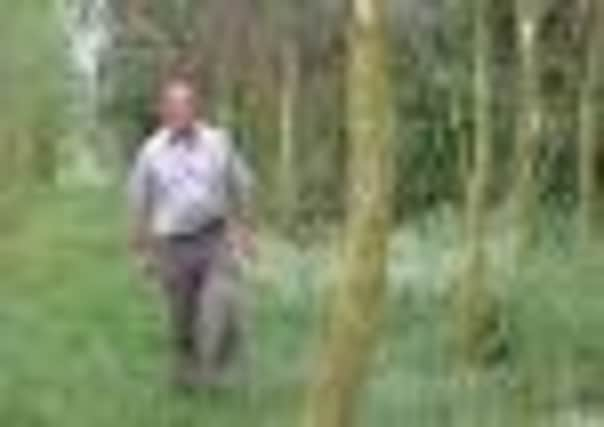Aussie trees that failed the English frost test


Until this year, Hornsea-based farmer and award-winning forester John Hepworth saw himself as the Buck Rogers of the forestry world.
“I thought eucalyptus trees were going to save the planet. The idea was that they were an ideal short rotation forest product that you harvested for the logs and went into biofuels for local woodburners. I have been accused of peddling the bandwagon for eucalyptus, and for that I don’t apologise. But never again.”
Advertisement
Hide AdAdvertisement
Hide AdJohn’s eucalyptus trees are dying, and at an alarming rate. He has planted 6,500 of them in the past eight years, and 5,000 were planted just two years ago.
“All of those 5,000 died in one go. All they ended up being useful for was as firelighters. They all came through last winter with minimal damage, but then, in April, I noticed that some bottom branches were dying. A fortnight later I saw that even more of the bottom branches had gone.
“I’ve since had experts from all over the country come to take a look and they have no answer. Where there was once good cover from the trees is also gone.”
John, of Braemar Farm, Rolston, had been sold on the idea that eucalyptus trees are the fastest growing trees in the world and that their calorific content made them three times more productive than any other tree.
Advertisement
Hide AdAdvertisement
Hide AdSeed had been brought over from Australia, New Zealand and Tasmania where a high tonnage per acre had been recorded.
He has now given up any hope of seeing such results on his farm which is 200 metres from the North Sea.
“In my opinion, this is the end for eucalyptus trees in the UK. It’s not that they cannot grow, it’s just that they cannot survive.
“My best tree is 45ft tall. It is supposedly the tallest eucalyptus in the UK and is only six years old. But it is 100 per cent dead.
Advertisement
Hide AdAdvertisement
Hide Ad“They seem to start with hairline cracks which then become wider in the trunk. Another sign is what appear to look like stretch marks you might find on a lady’s tummy.”
The reason for the damage he believes is clear.
“Water goes up a tree to feed the leaves. When it is cold, as it was when we were at minus 12 degrees in winter, the frost kills the cambium layer (the tissue between the wood and the bark of a tree). The quicker they grow, the harder they freeze.
“The tree is just not suitable in that kind of climate. I haven’t had problems with any of my other trees during the winter.”
Experts have advised John that has hasn’t lost all of his eucalyptus trees just yet. One or two of his older trees, which he planted eight years ago, may survive.
Advertisement
Hide AdAdvertisement
Hide AdThat’s no use to John who saw this enterprise as a green and eco-friendly business alternative after leaving dairy farming several years ago.
“What use is it to me planting a woodland that is absolutely divine every seven years just to see it die when it is supposed to be coming to fruition? That’s not progress.
“I have around 600-700 adult eucalyptus still alive at the moment and the only ones that may yet survive are the ones I started with.
“I know that some of them only appear to be cracked and some are sprouting again at the bottom. But if you’re going to go into large-scale production of forest residues, you cannot work like that. Whether they will be alive by Christmas is another matter.
Advertisement
Hide AdAdvertisement
Hide Ad“It is a very sad case of history for me now, and the company who were selling the seeds for the trees has gone from selling eight million a year to nothing, so that tells you something.
“I honestly believe that every eucalyptus in Britain under three years old, unless it is an ornamental variety which only grows six inches a year as opposed to 8ft per year, will be dead by Christmas.”
Many of John’s friends and fellow growers have been contacting him asking whether he can offer advice on their trees, including those who just have one or two in their garden.
“I have had a lot of phone calls and all I ask is that they go out in the garden with their phones. Many of them are then very surprised as they tell me that their trees have developed similar cracks three feet from the ground.”
Advertisement
Hide AdAdvertisement
Hide AdHis experience hasn’t made him reconsider forestry. John is a renowned pioneer.
“I’m a member of the Yorkshire Agricultural Adventurers and we are always looking to explore new avenues. While I planted 6,500 eucalyptus trees it was still a trial area, a research arboretum. I’ve lost money on it and it’s gone drastically wrong, but you don’t succeed every time.
“What I can do though is save others from making the same mistake. I might not be saving the planet, but there will another day for that.”
John’s woodlands include a vast variety of trees and two years ago he won the Royal Forestry Society Excellence in Forestry Farm Woodlands Award.
Advertisement
Hide AdAdvertisement
Hide AdHe started planting woodlands in 1989 and now has around 30 hectares in an area not traditionally known for forestry. He has also established the Hornsea Community Woodland which is open to the public. His other biofuel crop is 11 hectares of Swedish willow.
“I grow woodlands not just as an amenity but also as an income. It is a delight to see all sorts of people enjoying these woodlands.
“I am delighted to be involved in all that, but so far as eucalyptus trees are concerned, I think I’ll just disappear down a mouse hole and shut up for a while.”